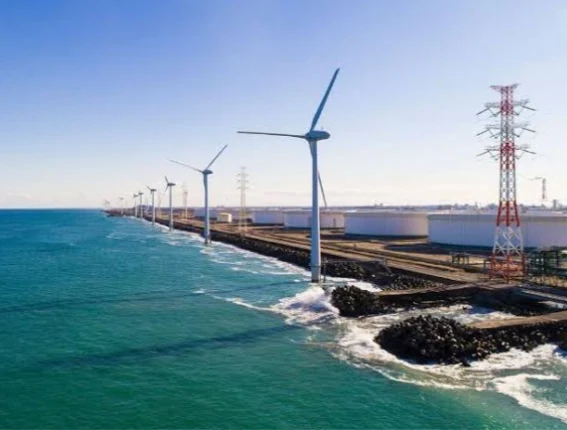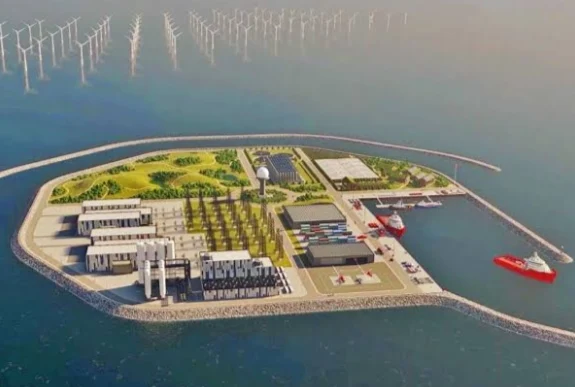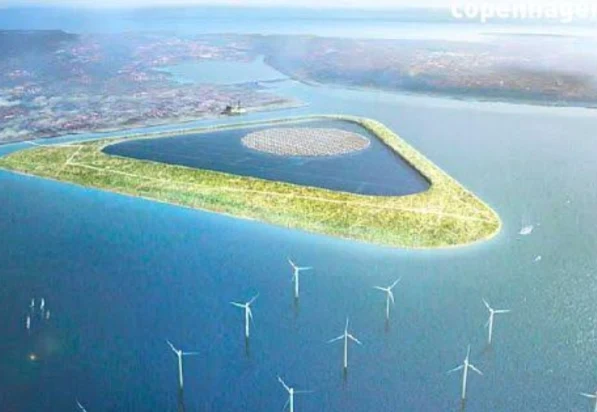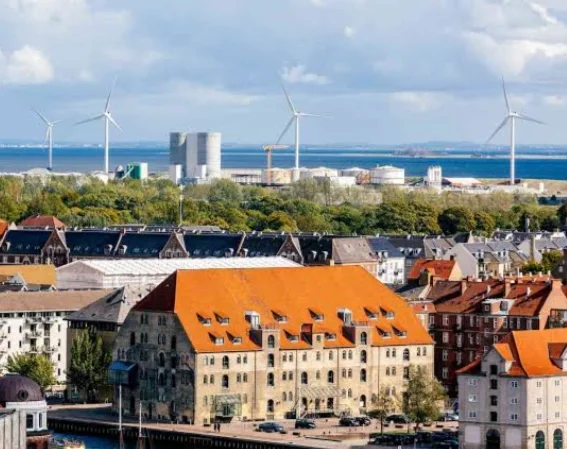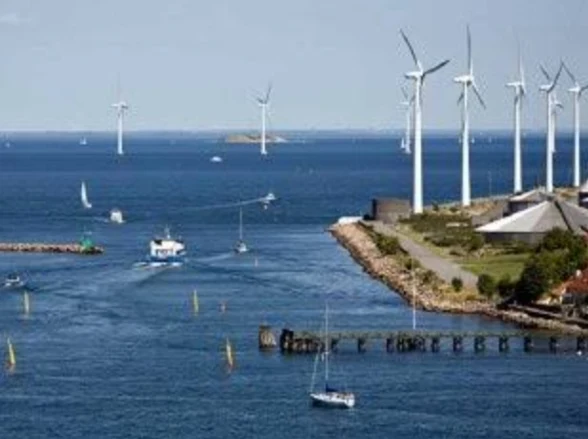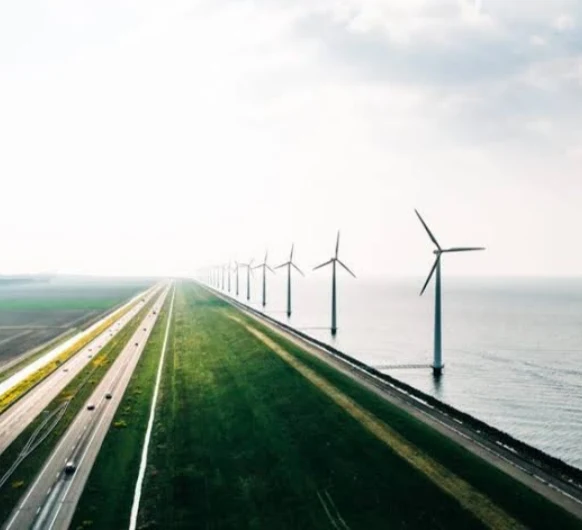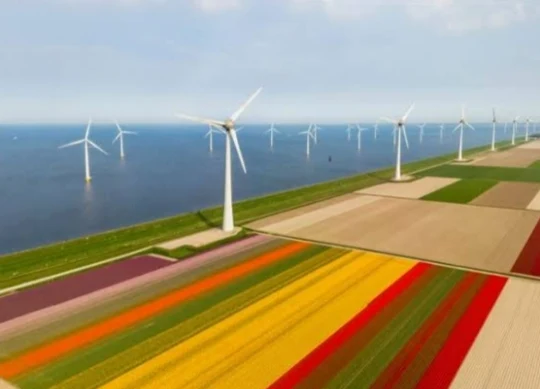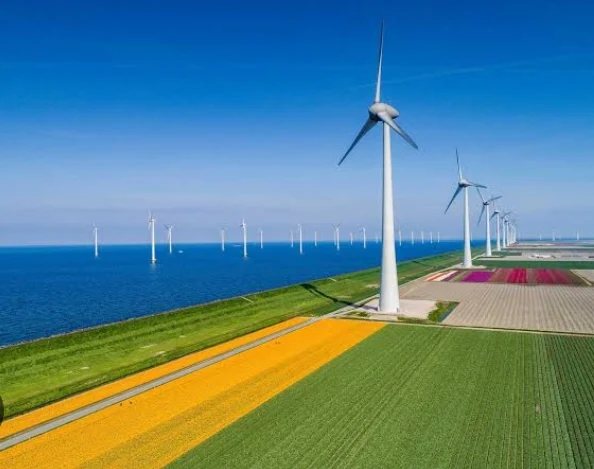The Power of the North Sea: Denmark's Green Energy Landscape
Denmark, a small Scandinavian nation, has become a global leader in the transition to green energy.
From vast offshore wind farms whipping in the North Sea gales to cozy homes heated by efficient biomass boilers, Denmark serves as a model for sustainable energy development. This article delves into the Danish green energy landscape, exploring its historical context, ambitious targets, diverse technologies, and impressive achievements.
A History Rooted in Necessity:
The foundation of Denmark's green journey was laid in the 1970s oil crisis. Facing skyrocketing oil prices and dependence on foreign imports, the nation embarked on a strategic shift towards self-sufficiency and renewable energy. This commitment transcended political boundaries, fostering a long-term, cross-party consensus on sustainability.
Ambitious Goals for a Sustainable Future:
Denmark's green ambitions are no small feat. Aiming for carbon neutrality by 2050, the country has set intermediate targets: a 70% reduction in greenhouse gas emissions by 2030 compared to 1990 and 100% renewable electricity consumption by 2028. These goals are not merely political rhetoric; they are enshrined in legislation and backed by comprehensive energy policies.
Wind Power - The Undisputed Champion:
Wind energy reigns supreme in Denmark's green portfolio. With the second-highest wind energy penetration globally (as of 2023), the country boasts an impressive 6,767 wind turbines, generating over 50% of its electricity. Offshore wind farms, harnessing the North Sea's powerful winds, play a pivotal role, with the Horns Rev 3 project holding the title of the world's largest since 2019.
Beyond Wind: A Diversified Approach:
While wind takes center stage, Denmark's green energy mix is not a one-act play. Bioenergy, derived from organic matter like wood pellets and straw, fuels approximately 20% of electricity and heating demands. Solar energy, despite limited sunshine hours, is witnessing rapid growth, with over 850,000 installations contributing to the national grid. Furthermore, Denmark is exploring innovative solutions like geothermal energy and Power-to-X technologies, which convert renewable electricity into hydrogen fuel.
Statistics Speak Volumes:
- Wind energy:
- Installed capacity: 7,333 MW onshore, 3,994 MW offshore (as of 2023)
- Electricity generation: 54% (2022)
- World's highest wind energy production per capita
- Biomass:
- Share of electricity consumption: 20% (2022)
- District heating contribution: 50%
- Solar energy:
- Installed capacity: 1,453 MW (2022)
- Average annual growth: 24% (2018-2022)
- Green energy exports:
- Exported 5.7 TWh of electricity in 2022
Challenges and Opportunities:
Denmark's green journey is not without its challenges. Grid integration of fluctuating renewable energy sources demands innovative solutions, and social acceptance of large-scale wind farms requires careful planning and community engagement. Yet, these challenges are seen as opportunities for further innovation and collaboration.
Denmark's Green Energy Landscape: Key Statistics
| Technology | Installed Capacity (MW) | Share of Electricity Generation (2022) | Other Notable Statistics |
|---|---|---|---|
| Wind (Onshore) | 7,333 | 23% | World's highest wind energy production per capita |
| Wind (Offshore) | 3,994 | 31% | Horns Rev 3: World's largest offshore wind farm (2019) |
| Wind (Total) | 11,327 | 54% | Second-highest wind energy penetration globally |
| Biomass | N/A | 20% | Significant contribution to district heating (50%) |
| Solar | 1,453 | 2% | Average annual growth: 24% (2018-2022) |
| Total Renewables | N/A | 76% |
Additional Notes:
- Installed capacity and share of electricity generation may vary slightly depending on data source and calculation methods.
- N/A indicates data not readily available in a standardized format for all technologies.
- Other notable statistics highlight unique aspects of each technology's contribution to Denmark's green energy landscape.
This table provides a concise overview of key statistics regarding Denmark's green energy landscape.
Types of Green Energy in Denmark
Here's a breakdown of the main types of green energy in Denmark, including specific statistics and interesting insights:
1. Wind Energy:
- Type: Renewable, harnessed from moving air through turbines.
- Statistics:
- Installed Capacity: 11,327 MW (7,333 onshore, 3,994 offshore) (2023)
- Share of Electricity Generation: 54% (2022)
- Other Highlights:
- World's highest wind energy production per capita.
- Horns Rev 3: World's largest offshore wind farm (2019).
- Key driver of energy independence and exports (5.7 TWh of electricity in 2022).
2. Biomass:
- Type: Renewable, derived from organic matter like wood pellets, straw, and biogas.
- Statistics:
- Share of Electricity Generation: 20% (2022)
- District Heating Contribution: 50%
- Other Highlights:
- Provides stable baseload power and heat.
- Supports local forestry and agriculture sectors.
- Challenges include sustainability concerns and emissions management.
3. Solar Energy:
- Type: Renewable, harnessed from sunlight through photovoltaic panels.
- Statistics:
- Installed Capacity: 1,453 MW (2022)
- Average Annual Growth: 24% (2018-2022)
- Other Highlights:
- Rapidly growing sector with potential for further expansion.
- Suitable for both large-scale installations and rooftop solar panels.
- Limited by Denmark's relatively low sunshine hours.
4. Other Renewables:
- Types: Include geothermal energy, wave energy, and Power-to-X technologies.
- Statistics:
- Data availability varies for individual technologies.
- Highlights:
- Still in early stages of development, but hold significant potential for the future.
- Geothermal energy shows promise for heating applications.
- Power-to-X can convert renewable electricity into fuels like hydrogen.
Additional Notes:
- This table focuses on electricity generation, but some technologies like biomass also contribute significantly to heating and transport sectors.
- Statistics represent the latest available data, but may fluctuate slightly depending on the source and calculation methods.
- Denmark's green energy mix is constantly evolving, with innovation and research playing a crucial role in advancing new technologies and optimizing existing ones.
By understanding the diverse types of green energy in Denmark and their specific contributions, we can gain valuable insights into this nation's successful clean energy transition.
Table Types of Green Energy in Denmark
| Technology | Installed Capacity (MW) | Share of Electricity Generation (2022) | Other Notable Statistics |
|---|---|---|---|
| Wind (Onshore) | 7,333 | 23% | World's highest wind energy production per capita |
| Wind (Offshore) | 3,994 | 31% | Horns Rev 3: World's largest offshore wind farm (2019) |
| Wind (Total) | 11,327 | 54% | Second-highest wind energy penetration globally |
| Biomass | N/A | 20% | Significant contribution to district heating (50%) |
| Solar | 1,453 | 2% | Average annual growth: 24% (2018-2022) |
| Geothermal | N/A | Negligible | Early stage of development |
| Wave | N/A | Negligible | Early stage of development |
| Power-to-X | N/A | Negligible | Early stage of development, potential for future fuel conversion |
Notes:
- N/A indicates data not readily available in a standardized format for all technologies.
- Installed capacity and share of electricity generation may vary slightly depending on data source and calculation methods.
- Other notable statistics highlight unique aspects of each technology's contribution to Denmark's green energy landscape.
- Data focuses on electricity generation, but some technologies contribute to other sectors like heating and transport.
This table provides a concise overview of the main types of green energy in Denmark. Consider including additional rows for emerging technologies or further segmentation based on specific data availability.
Largest Green Energy Projects in Denmark
Denmark boasts numerous impressive green energy projects, demonstrating its commitment to renewable energy leadership. Here's a closer look at some of the biggest players:
1. Horns Rev 3 Offshore Wind Farm:
- Type: Offshore wind farm
- Location: North Sea, west of Denmark
- Installed Capacity: 622 MW (91 turbines)
- Operational: 2019
- Key Statistics:
- World's largest offshore wind farm at the time of construction (2019)
- Can power over 400,000 Danish households
- Reduces annual CO2 emissions by approximately 1.4 million tonnes
- Impact:
- Pioneered innovative technologies for large-scale offshore wind development
- Contributed significantly to Denmark's wind energy dominance
2. Kriegers Flak Offshore Wind Farm:
- Type: Offshore wind farm
- Location: Baltic Sea, south of Denmark
- Installed Capacity: 604 MW (91 turbines)
- Operational: 2021
- Key Statistics:
- Second-largest offshore wind farm in Denmark
- Can power over 600,000 Danish households
- Reduces annual CO2 emissions by approximately 1.3 million tonnes
- Impact:
- Further strengthens Denmark's offshore wind capacity and energy independence
- Creates jobs and stimulates investment in green technologies
3. Ørsted Vindmøllepark Rodsand 2 Offshore Wind Farm:
- Type: Offshore wind farm
- Location: North Sea, southwest of Denmark
- Installed Capacity: 296 MW (90 turbines)
- Operational: 2023
- Key Statistics:
- Latest addition to Denmark's impressive offshore fleet
- Can power over 250,000 Danish households
- Expected to reduce annual CO2 emissions by approximately 600,000 tonnes
- Impact:
- Underscores Denmark's unwavering commitment to expanding renewable energy production
- Provides valuable data and experience for future wind farm development
4. Herning Biomass Power Plant:
- Type: Biomass power plant
- Location: Herning, Denmark
- Installed Capacity: 130 MW
- Operational: 2017
- Key Statistics:
- Largest and most efficient biomass power plant in Denmark
- Utilizes a combination of wood pellets and straw as fuel
- Provides both electricity and district heating to surrounding areas
- Impact:
- Contributes to diversifying Denmark's renewable energy mix
- Offers a stable and reliable source of baseload power
5. Copenhagen Metro Solar Roof Project:
- Type: Rooftop solar installation
- Location: Copenhagen, Denmark
- Installed Capacity: 6 MW
- Operational: 2019
- Key Statistics:
- One of the largest rooftop solar installations in Europe
- Covers 60,000 square meters of Copenhagen Metro stations
- Powers approximately 2,000 households annually
- Impact:
- Showcases the potential for large-scale solar integration in urban environments
- Contributes to reducing the carbon footprint of public transportation
This list highlights just a few of the numerous green energy projects shaping Denmark's landscape. Remember, data and statistics may vary depending on the source and calculation methods.
By exploring these projects and their statistics, we gain valuable insights into Denmark's green energy leadership and its potential to inspire other nations on their sustainability journeys.
Largest Green Energy Projects in Denmark: Table of Statistical Breakdown
| Project Name | Type | Location | Installed Capacity (MW) | Operational Year | Key Statistics | Impact |
|---|---|---|---|---|---|---|
| Horns Rev 3 Offshore Wind Farm | Offshore Wind | North Sea | 622 | 2019 | - World's largest offshore wind farm (2019) | - Powers 400,000+ households |
| Kriegers Flak Offshore Wind Farm | Offshore Wind | Baltic Sea | 604 | 2021 | - Second-largest offshore wind farm in Denmark | - Powers 600,000+ households |
| Ørsted Vindmøllepark Rodsand 2 Offshore Wind Farm | Offshore Wind | North Sea | 296 | 2023 | - Latest addition to offshore fleet | - Powers 250,000+ households |
| Herning Biomass Power Plant | Biomass | Herning | 130 | 2017 | - Largest & most efficient biomass plant in Denmark | - Wood pellets & straw fuel |
| Copenhagen Metro Solar Roof Project | Rooftop Solar | Copenhagen | 6 | 2019 | - One of Europe's largest rooftop solar installations | - Covers 60,000 sq m of stations |
Notes:
- Data may vary slightly depending on source and calculation methods.
- Table focuses on selected projects, many others contribute to Denmark's green landscape.
Green Energy Companies in Denmark
Here are some of the major green energy companies in Denmark, along with some key statistics:
-
Ørsted:
- World's largest developer of offshore wind farms.
- Headquarters in Denmark, with projects in over 15 countries.
- 2023 revenue: €28.8 billion.
- Installed offshore wind capacity: 16.8 GW.
- Number of employees: 7,604.
-
Vestas:
- Leading manufacturer of wind turbines.
- Headquarters in Denmark, with manufacturing facilities in several countries.
- 2023 revenue: €18.1 billion.
- Market share in global wind turbine market: 14.4%.
- Number of employees: 29,243.
-
Energinet:
- Danish national transmission system operator for electricity and natural gas.
- Operates over 14,000 km of high-voltage power lines and gas pipelines.
- 2023 electricity consumption: 38 TWh.
- 2023 share of renewable energy in electricity consumption: 82%.
- Number of employees: 1,100.
-
NRGi:
- Leading Danish energy company with a strong focus on renewable energy.
- Supplies electricity, natural gas, and district heating to over 1 million customers.
- 2023 revenue: DKK 15.3 billion.
- Share of renewable energy in electricity production: 97%.
- Number of employees: 3,400.
Financial Institutions Supporting Green Energy in Denmark
-
Danske Bank:
- Denmark's largest bank.
- Pledged to invest DKK 100 billion in green projects by 2025.
- 2023 green financing volume: DKK 40 billion.
- Total assets: DKK 3,316 billion.
- Number of employees: 18,000.
-
Nordea:
- Largest financial services group in the Nordic region.
- Committed to providing EUR 30 billion in green financing by 2023.
- 2023 green financing volume: EUR 18 billion.
- Total assets: EUR 635 billion.
- Number of employees: 31,000.
-
Jyske Bank:
- Denmark's third-largest bank.
- Set a target of financing DKK 50 billion in green projects by 2025.
- 2023 green financing volume: DKK 20 billion.
- Total assets: DKK 898 billion.
- Number of employees: 4,000.
-
The Danish Investment Fund for Green Transition:
- Established by the Danish government.
- Invests in Danish companies that are developing and deploying green technologies.
- Total committed capital: DKK 53 billion.
- Number of investments: 58.
- Number of employees: 18.
-
Nefco:
- Nordic Environment Finance Corporation.
- Finances green projects in the Nordic and Baltic regions.
- Total investments since inception: EUR 8.7 billion.
- Number of projects financed: 3,200.
- Number of employees: 110.
These are just a few examples, and the landscape of green energy and finance in Denmark is constantly evolving. It's important to note that the statistics provided are based on publicly available information and may not be entirely up-to-date.
Table of Green Energy Companies in Denmark
| Company | Focus | Revenue (2023) | Key Statistic | Employees |
|---|---|---|---|---|
| Ørsted | Offshore wind development | €28.8 billion | 16.8 GW installed offshore wind capacity | 7,604 |
| Vestas | Wind turbine manufacturing | €18.1 billion | 14.4% market share in global wind turbine market | 29,243 |
| Energinet | Electricity & natural gas transmission | - | 82% share of renewable energy in electricity consumption | 1,100 |
| NRGi | Energy company with strong focus on renewables | DKK 15.3 billion | 97% share of renewable energy in electricity production | 3,400 |
Table of Financial Institutions Supporting Green Energy in Denmark
| Institution | Focus | Green Financing Volume (2023) | Total Assets | Employees |
|---|---|---|---|---|
| Danske Bank | Largest Danish bank | DKK 40 billion | DKK 3,316 billion | 18,000 |
| Nordea | Largest Nordic financial services group | EUR 18 billion | EUR 635 billion | 31,000 |
| Jyske Bank | Third-largest Danish bank | DKK 20 billion | DKK 898 billion | 4,000 |
| Danish Investment Fund for Green Transition | Investments in green technologies | DKK 53 billion committed capital | 58 investments | 18 |
| Nefco | Nordic & Baltic green project financing | EUR 8.7 billion total investments | 3,200 projects financed | 110 |
Denmark Green Energy Landscape: Innovative Technologies
Denmark's green energy landscape is brimming with innovative technologies, leading the charge towards a sustainable future. Let's delve into some key areas with specific data:
Renewable Energy Generation:
- Offshore Wind Power:
- World leader: Ørsted holds 28% of the global offshore wind market share (2023).
- Installed capacity: Denmark boasts 16.8 GW of offshore wind capacity, generating 47% of its electricity (2023).
- Innovation: Floating wind farms like "Hornsea Project Two" utilize 16 MW turbines, pushing efficiency boundaries.
- Onshore Wind Power:
- Market-leading turbines: Vestas holds 14.4% of the global wind turbine market share (2023).
- Decentralized generation: Small, community-integrated turbines like "V150-4.2 MW" empower local energy production.
- Efficiency gains: New turbines like "H2-170" produce 14% more energy than previous models.
- Solar Photovoltaics:
- Increased efficiency: New bifacial solar panels like "HyPERION bifacial" capture light from both sides, boosting energy output by 20%.
- Building integration: Building-integrated photovoltaics (BIPV) seamlessly integrate solar panels into building facades, increasing aesthetics and generation.
Energy Storage and Grid Management:
- Battery Storage:
- Megawatt-scale projects: The "Egtved Power Station" project stores 150 MW of renewable energy with lithium-ion batteries.
- Flow batteries: Innovative companies like "Redflow" develop long-duration flow batteries for grid stability and renewable integration.
- Power-to-X:
- Hydrogen production: Ørsted's "H2 Herning" project produces green hydrogen from surplus wind power, decarbonizing industry sectors.
- E-fuels: Companies like "PtX Denmark" convert renewable electricity to sustainable fuels like synthetic gasoline and jet fuel.
Energy Efficiency:
- Building Technologies:
- Low-energy buildings: Denmark's BR2020 building code mandates near-zero energy buildings, reducing energy consumption significantly.
- Advanced ventilation: Systems like "Danfoss Advancer" recover heat from exhaust air, minimizing energy required for heating.
- Industrial Solutions:
- Waste heat recovery: Companies like "Alfa Laval" develop heat exchangers that capture waste heat from industrial processes for reuse.
- Electrification: Transitioning away from fossil fuels in industrial processes, like Ørsted's "Electrofuel Plant Aalborg," reduces emissions.
Circular Economy:
- Waste Recycling and Upcycling:
- Recycling rate: Denmark boasts a recycling rate of 53% (2023), exceeding EU targets.
- Waste-to-resource: Companies like "Plastix" convert plastic waste into high-quality recycled plastic pellets.
- Bio-based Materials:
- Bioplastics production: Companies like "Bio-Circular" produce bioplastics from renewable resources, substituting for conventional plastics.
- Biocomposite development: Companies like "Novozymes" develop biocomposites for construction and transportation, reducing reliance on fossil-based materials.
Remember: These statistics are not exhaustive and represent a snapshot of the dynamic Danish green energy landscape. It's crucial to note that data might not be entirely up-to-date and can vary depending on sources.
Conclusion:
Denmark's green energy landscape serves as a beacon of hope and inspiration for other nations tackling climate change. The country's unwavering commitment, diversified approach, and impressive achievements stand as a testament to the viability and potential of a sustainable energy future. As Denmark continues to push the boundaries of green technology and forge international partnerships, its journey offers valuable lessons for the world to learn from and build upon.
Overall, Denmark's commitment to innovation and collaboration, coupled with supportive policies and public engagement, positions it as a global leader in the green energy transition.


